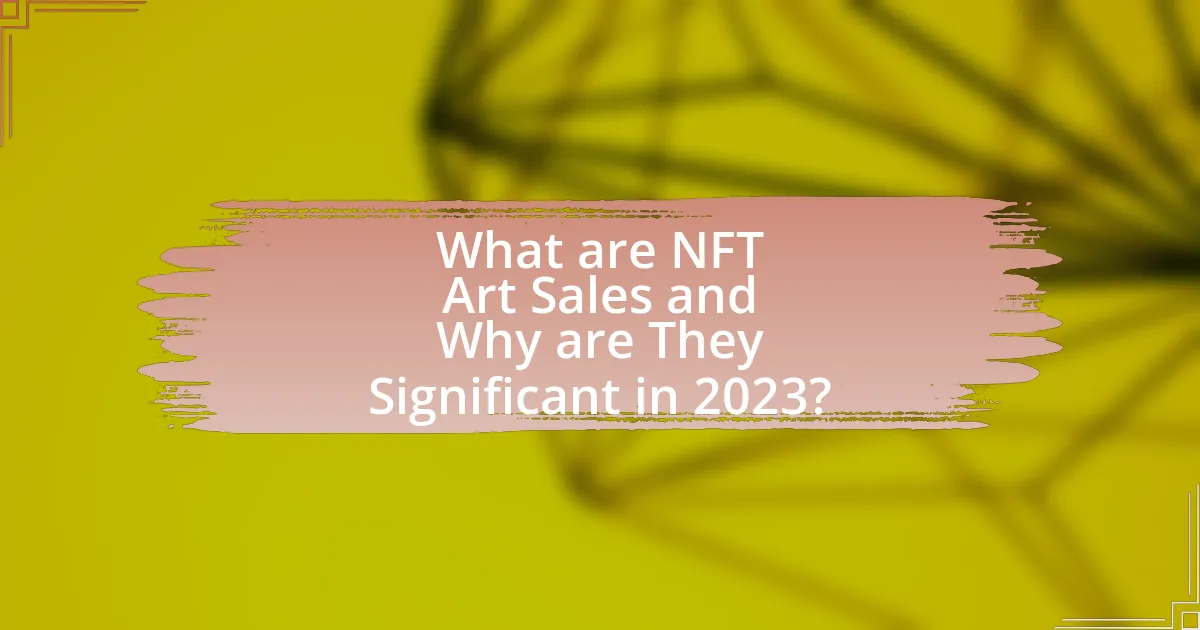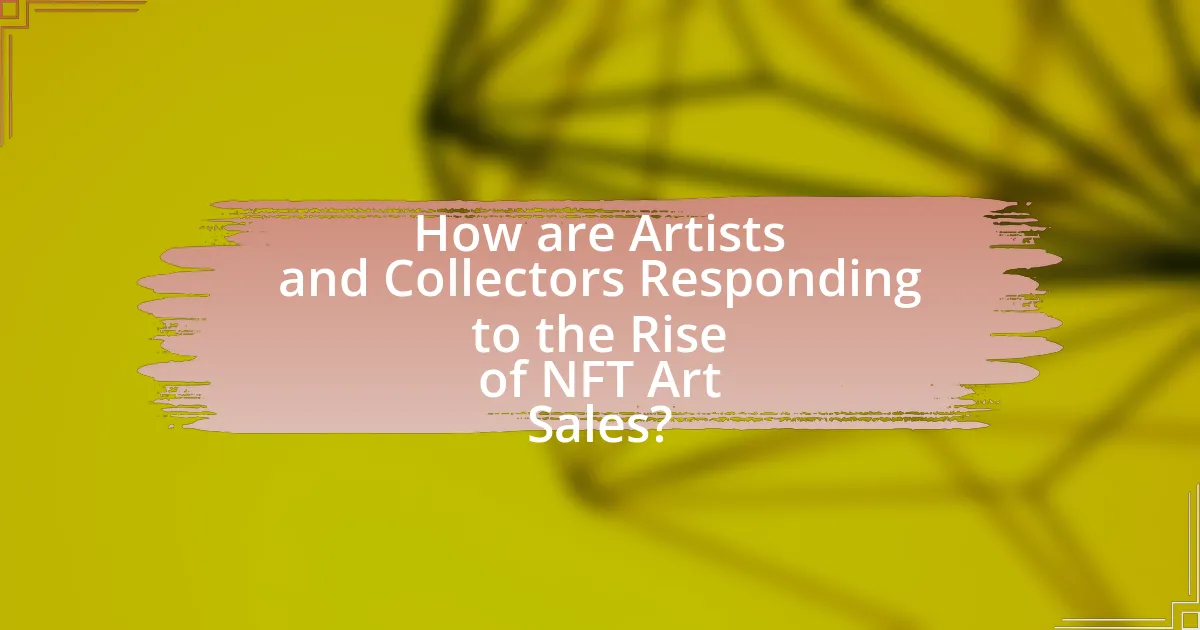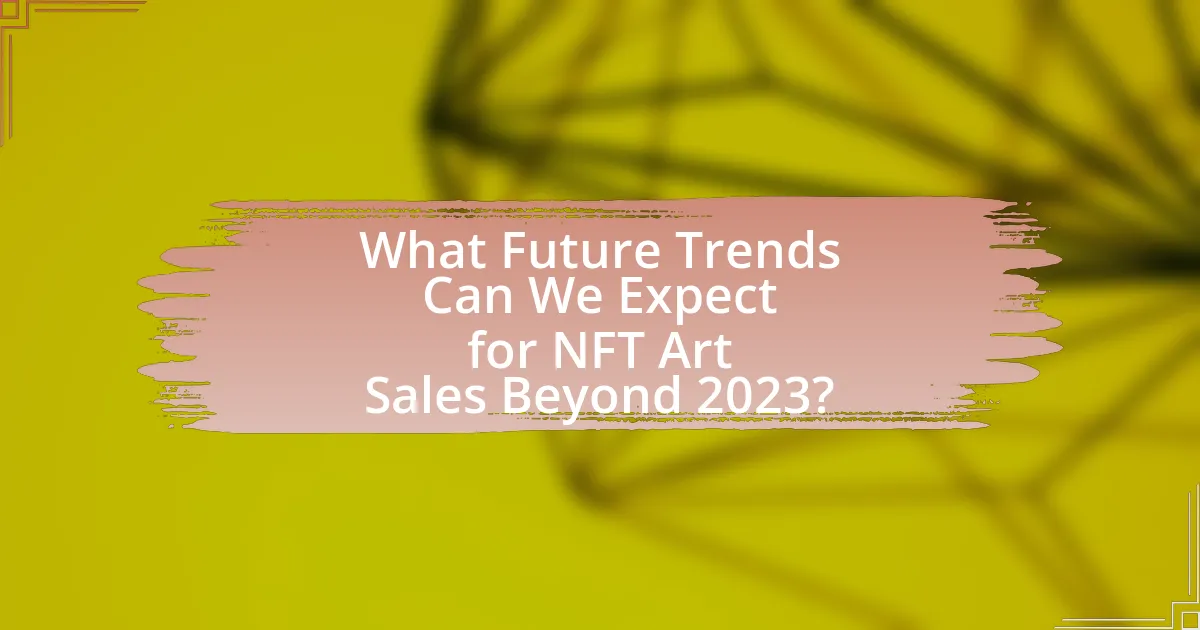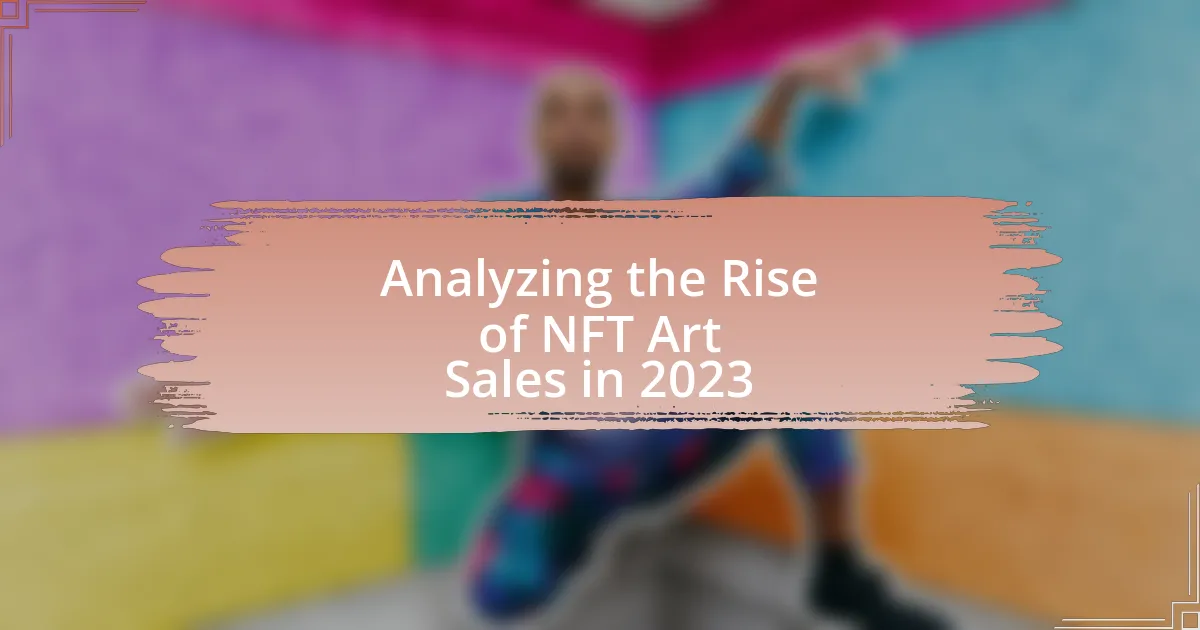NFT art sales, which involve transactions of digital artworks authenticated through blockchain technology as non-fungible tokens (NFTs), have gained significant traction in 2023, generating approximately $2 billion in sales in the first quarter alone. The article explores the evolution of NFT art sales, highlighting key milestones, the comparison with traditional art sales, and the factors driving their rise, including mainstream adoption and technological advancements. It also addresses challenges such as market volatility and regulatory concerns, while examining the implications for artists and collectors, including opportunities for revenue generation and strategies for informed investment. Additionally, the article discusses future trends, innovations in NFT marketplaces, and the potential impact of regulations on the NFT art landscape.

What are NFT Art Sales and Why are They Significant in 2023?
NFT art sales refer to the transactions involving digital artworks that are authenticated and owned through blockchain technology, specifically as non-fungible tokens (NFTs). In 2023, these sales are significant due to their transformative impact on the art market, enabling artists to monetize their work directly and providing collectors with verifiable ownership and provenance. The NFT art market generated approximately $2 billion in sales in the first quarter of 2023, reflecting a growing acceptance and integration of digital art into mainstream culture. This surge highlights the shift in how art is created, bought, and sold, as well as the increasing interest from both traditional art collectors and new investors in the digital space.
How have NFT Art Sales evolved over the years?
NFT art sales have significantly increased since their inception, particularly experiencing explosive growth in 2021. In that year, the total sales volume reached approximately $2.5 billion, a stark contrast to the mere $13.7 million recorded in 2020. This surge was driven by high-profile sales, such as Beeple’s “Everydays: The First 5000 Days,” which sold for $69 million at Christie’s. Following this peak, the market saw fluctuations, with sales declining to around $1 billion in 2022, yet the interest in NFT art remains strong, as evidenced by ongoing sales and new platforms emerging in 2023. The evolution of NFT art sales reflects a growing acceptance of digital ownership and the integration of blockchain technology in the art world.
What key milestones have marked the growth of NFT Art Sales?
Key milestones that have marked the growth of NFT art sales include the sale of Beeple’s “Everydays: The First 5000 Days” for $69 million at Christie’s in March 2021, which brought mainstream attention to NFTs. Following this, the NFT market saw explosive growth, with total sales reaching approximately $25 billion in 2021, according to NonFungible.com. In 2022, major brands like Nike and Adidas entered the NFT space, further legitimizing the market. Additionally, the launch of platforms like OpenSea and Rarible facilitated easier access for artists and collectors, contributing to the overall expansion of NFT art sales.
How do NFT Art Sales compare to traditional art sales?
NFT art sales significantly differ from traditional art sales in terms of accessibility, transaction speed, and market dynamics. NFT art sales occur on digital platforms, allowing artists to reach a global audience instantly, whereas traditional art sales often involve galleries and physical exhibitions, limiting access. In 2021, NFT art sales reached approximately $2.5 billion, showcasing rapid growth compared to the traditional art market, which was valued at around $65 billion in the same year. Additionally, NFT transactions are recorded on blockchain technology, ensuring transparency and provenance, while traditional art relies on physical documentation, which can be prone to forgery. This shift towards digital assets reflects changing consumer preferences and technological advancements in the art world.
What factors are driving the rise of NFT Art Sales in 2023?
The rise of NFT art sales in 2023 is primarily driven by increased mainstream adoption, technological advancements, and a growing interest in digital ownership. Mainstream adoption is evidenced by major brands and celebrities entering the NFT space, which has significantly boosted visibility and credibility. Technological advancements, such as improved blockchain scalability and user-friendly platforms, have made it easier for artists and collectors to engage with NFTs. Additionally, the growing interest in digital ownership reflects a cultural shift towards valuing unique digital assets, with reports indicating that NFT sales reached approximately $2 billion in the first quarter of 2023, highlighting the market’s robust growth.
How has technology influenced the popularity of NFT Art?
Technology has significantly influenced the popularity of NFT Art by enabling secure ownership and provenance tracking through blockchain. The decentralized nature of blockchain technology allows artists to tokenize their work, ensuring authenticity and scarcity, which are critical factors driving demand. Additionally, platforms like OpenSea and Rarible have made it easier for creators to mint, sell, and showcase their digital art, expanding access to a global audience. The integration of social media and online marketplaces has further amplified visibility, allowing artists to reach potential buyers directly. As a result, the market for NFT Art has surged, with sales reaching over $2 billion in the first quarter of 2023 alone, highlighting the profound impact of technology on this emerging art form.
What role do social media and influencers play in NFT Art Sales?
Social media and influencers significantly drive NFT art sales by enhancing visibility and creating demand. Platforms like Twitter, Instagram, and TikTok allow artists to showcase their work to a global audience, while influencers leverage their follower base to promote specific NFTs, often leading to increased sales. For instance, a study by NonFungible.com reported that social media engagement correlates with higher sales volumes, indicating that effective promotion through these channels can lead to substantial financial success for NFT artists.
What challenges are faced by NFT Art Sales in 2023?
NFT art sales in 2023 face several significant challenges, including market volatility, regulatory uncertainty, and environmental concerns. Market volatility is evident as the prices of NFTs can fluctuate dramatically, leading to uncertainty for both artists and collectors. Regulatory uncertainty arises from the evolving legal landscape surrounding digital assets, which can impact the legitimacy and security of NFT transactions. Additionally, environmental concerns related to the energy consumption of blockchain networks used for NFT transactions have led to criticism and calls for more sustainable practices. These challenges collectively hinder the growth and acceptance of NFT art in the broader art market.
How do issues of copyright and ownership affect NFT Art Sales?
Issues of copyright and ownership significantly impact NFT art sales by determining the legal rights associated with the digital assets. When an NFT is sold, the ownership of the token does not automatically confer copyright ownership of the underlying artwork, which can lead to disputes over usage rights. For instance, if an artist sells an NFT without transferring copyright, the buyer may not have the right to reproduce or display the artwork commercially. This distinction is crucial, as evidenced by legal cases where artists have sought to reclaim rights over their work after NFT sales, highlighting the need for clear agreements regarding copyright. Furthermore, platforms facilitating NFT sales often require users to confirm that they hold the necessary rights to the artwork, underscoring the importance of ownership clarity in the market.
What are the environmental concerns associated with NFT Art Sales?
The environmental concerns associated with NFT art sales primarily stem from the high energy consumption of blockchain technology, particularly those that utilize proof-of-work systems. For instance, the Ethereum blockchain, which has been widely used for NFTs, was reported to consume approximately 45 terawatt-hours of electricity annually, comparable to the energy usage of entire countries like Qatar. This significant energy demand contributes to increased carbon emissions, raising concerns about the environmental impact of minting and trading NFTs. Additionally, the electronic waste generated from the hardware used in mining operations further exacerbates these environmental issues.

How are Artists and Collectors Responding to the Rise of NFT Art Sales?
Artists are increasingly embracing NFT art sales as a new revenue stream and a way to reach broader audiences. Many artists are creating digital works specifically for NFT platforms, allowing them to monetize their art in ways that traditional galleries do not facilitate. Collectors, on the other hand, are responding by investing in NFTs as a form of digital ownership, often viewing them as a speculative asset with potential for appreciation. According to a report by NonFungible.com, the NFT market saw a significant increase in sales volume, reaching over $10 billion in 2021, indicating strong interest from both artists and collectors. This trend reflects a shift in how art is created, sold, and valued in the digital age.
What opportunities do NFT Art Sales present for artists?
NFT art sales present significant opportunities for artists by enabling direct access to global markets and providing new revenue streams. Artists can sell their work directly to collectors without intermediaries, which increases their profit margins. Additionally, NFTs allow for the inclusion of smart contracts, enabling artists to earn royalties on secondary sales, thus creating ongoing income from their work. The NFT market has seen exponential growth, with sales reaching over $10 billion in 2021, demonstrating the demand for digital art and the potential for artists to capitalize on this trend.
How can artists leverage NFT platforms to reach new audiences?
Artists can leverage NFT platforms to reach new audiences by creating unique digital assets that appeal to collectors and enthusiasts. By minting their artwork as NFTs, artists can tap into a global market that values digital ownership and scarcity. Platforms like OpenSea and Rarible provide access to diverse audiences, enabling artists to showcase their work to potential buyers who are specifically interested in digital art. Additionally, the integration of social media and community engagement on these platforms allows artists to build a following and connect with fans, further expanding their reach. The NFT market has seen exponential growth, with sales reaching over $10 billion in 2021, demonstrating the significant opportunity for artists to engage with new audiences through this medium.
What are the financial implications for artists entering the NFT market?
Artists entering the NFT market can experience significant financial implications, including potential for high earnings through sales and royalties. The NFT market has seen explosive growth, with sales reaching $25 billion in 2021, indicating a lucrative opportunity for artists. Additionally, artists can earn ongoing royalties from secondary sales, typically around 10-30%, which provides a continuous revenue stream. However, artists also face risks such as market volatility and high transaction fees on blockchain platforms, which can impact profitability. The financial landscape for artists in the NFT space is thus characterized by both substantial earning potential and inherent risks.
How are collectors adapting to the NFT Art landscape?
Collectors are adapting to the NFT art landscape by diversifying their portfolios and engaging with digital platforms. This shift is evident as traditional art collectors increasingly invest in NFTs, recognizing the potential for high returns and unique ownership experiences. According to a report by NonFungible.com, NFT art sales reached $2.6 billion in the first quarter of 2023, indicating a growing interest among collectors. Additionally, many collectors are utilizing social media and online marketplaces to discover and purchase NFT art, further integrating digital assets into their collections. This adaptation reflects a broader trend of embracing technology and innovation within the art market.
What strategies are collectors using to invest in NFT Art?
Collectors are employing several strategies to invest in NFT art, including diversifying their portfolios, focusing on established artists, and leveraging social media for insights. Diversification allows collectors to mitigate risks by investing in various types of NFTs across different platforms. By concentrating on established artists, collectors can increase the likelihood of value appreciation, as works from recognized creators tend to have higher demand. Additionally, utilizing social media platforms enables collectors to stay informed about trends and emerging artists, which can lead to timely investment opportunities. These strategies reflect a calculated approach to navigating the volatile NFT art market, where informed decisions can significantly impact investment outcomes.
How do collectors assess the value of NFT Art pieces?
Collectors assess the value of NFT art pieces primarily through factors such as rarity, provenance, and market demand. Rarity refers to the uniqueness of the NFT, with limited editions or one-of-a-kind pieces typically commanding higher prices. Provenance involves the history of ownership and the artist’s reputation, which can significantly influence perceived value; for instance, works by well-known artists often sell for more due to their established credibility. Market demand is gauged through sales data and trends, where recent auction results and trading volumes provide insights into what collectors are willing to pay. According to a report by NonFungible.com, the NFT market saw a surge in sales, with a total market cap exceeding $10 billion in 2021, indicating strong demand and interest in digital art.

What Future Trends Can We Expect for NFT Art Sales Beyond 2023?
Future trends for NFT art sales beyond 2023 will likely include increased integration with virtual and augmented reality platforms, enhancing the immersive experience of art ownership. As technology evolves, artists and collectors will leverage these platforms to create and showcase art in interactive environments, driving demand. Additionally, the rise of fractional ownership will enable more investors to participate in high-value NFT art markets, democratizing access and potentially increasing sales volume. Market data indicates that the NFT market has already seen significant growth, with sales reaching over $25 billion in 2021, suggesting a strong foundation for future expansion. Furthermore, collaborations between traditional art institutions and blockchain platforms are expected to increase, legitimizing NFT art and attracting a broader audience.
How might technological advancements shape the future of NFT Art Sales?
Technological advancements will significantly shape the future of NFT art sales by enhancing accessibility, improving security, and enabling innovative features. For instance, the integration of blockchain technology ensures transparent ownership and provenance, which builds trust among buyers. Additionally, advancements in artificial intelligence can facilitate personalized art recommendations, making it easier for collectors to discover new artists and pieces. Furthermore, developments in virtual reality and augmented reality may allow potential buyers to experience art in immersive environments before making a purchase, thereby increasing engagement and sales. These factors collectively indicate that technology will play a crucial role in transforming how NFT art is bought, sold, and experienced.
What innovations are on the horizon for NFT marketplaces?
Innovations on the horizon for NFT marketplaces include enhanced interoperability, which allows NFTs to be traded across different platforms seamlessly. This development is driven by the need for a more unified ecosystem, enabling users to access a broader range of assets and experiences. Additionally, the integration of Layer 2 solutions is expected to improve transaction speeds and reduce gas fees, making NFT trading more accessible. According to a report by NonFungible.com, the NFT market is projected to grow significantly, with advancements in user experience and security protocols further attracting mainstream adoption.
How could augmented reality and virtual reality impact NFT Art experiences?
Augmented reality (AR) and virtual reality (VR) could significantly enhance NFT art experiences by providing immersive environments for viewing and interacting with digital artworks. AR allows users to overlay digital art onto the physical world, enabling them to visualize NFTs in their own spaces, which can increase engagement and appreciation. For instance, platforms like Artivive utilize AR to bring static artworks to life, creating a dynamic interaction that traditional displays cannot offer. VR, on the other hand, creates fully immersive environments where users can explore virtual galleries and interact with art in a three-dimensional space, as seen in applications like Cryptovoxels and Decentraland. These technologies not only enhance the aesthetic experience but also facilitate social interactions among users, fostering community engagement around NFT art. The integration of AR and VR in NFT art experiences is supported by the growing trend of virtual exhibitions, which saw a 300% increase in participation in 2023, indicating a shift towards more interactive and engaging art consumption methods.
What are the potential regulatory changes affecting NFT Art Sales?
Potential regulatory changes affecting NFT art sales include increased scrutiny from financial regulators, which may lead to the classification of NFTs as securities. This classification could impose stricter compliance requirements on NFT platforms and artists, including registration and disclosure obligations. For instance, the U.S. Securities and Exchange Commission (SEC) has indicated that certain NFTs may fall under its jurisdiction, particularly those that offer fractional ownership or investment-like characteristics. Additionally, global regulatory bodies are considering frameworks to address issues such as copyright infringement, consumer protection, and taxation related to NFT transactions. These developments suggest a shift towards more formalized regulations that could significantly impact how NFT art is created, sold, and traded.
How might governments respond to the rise of NFT Art Sales?
Governments might respond to the rise of NFT art sales by implementing regulatory frameworks to address taxation, intellectual property rights, and consumer protection. For instance, countries like the United States and the European Union are already exploring how to classify NFTs for tax purposes, which could lead to new tax obligations for creators and buyers. Additionally, governments may establish guidelines to protect artists’ rights, ensuring that creators receive royalties from secondary sales, similar to traditional art markets. This response is supported by ongoing discussions in legislative bodies about the need for clarity in digital asset regulations, reflecting a growing recognition of the economic impact of NFTs in the art sector.
What implications do regulations have for artists and collectors?
Regulations significantly impact artists and collectors by establishing legal frameworks that govern the creation, sale, and ownership of digital art, particularly NFTs. These regulations can enhance consumer protection, ensuring that artists receive royalties from secondary sales, as seen in jurisdictions like California, where laws mandate such provisions. Additionally, regulations can impose compliance requirements, such as anti-money laundering measures, which may complicate transactions for collectors and require them to verify the legitimacy of their purchases. The enforcement of intellectual property rights through regulations also helps artists protect their work from unauthorized use, thereby fostering a more secure marketplace. Overall, regulations shape the operational landscape for both artists and collectors, influencing their rights, responsibilities, and the overall integrity of the NFT art market.
What best practices should artists and collectors follow in the NFT Art market?
Artists and collectors in the NFT Art market should prioritize transparency, authenticity, and community engagement. Transparency involves clearly communicating the provenance and details of each NFT, which builds trust among buyers. Authenticity is crucial; artists must ensure their work is original and properly attributed to avoid copyright issues. Community engagement fosters relationships and loyalty, encouraging collectors to support artists and share their work. According to a report by NonFungible.com, transparency in transactions and community involvement significantly enhances the value and desirability of NFTs, leading to increased sales and market growth.
How can artists protect their work in the NFT space?
Artists can protect their work in the NFT space by utilizing copyright registration, smart contracts, and watermarking. Copyright registration provides legal recognition of ownership, allowing artists to enforce their rights against unauthorized use. Smart contracts, embedded in the NFT, can stipulate terms of sale and royalties, ensuring artists receive compensation for future sales. Watermarking digital art can deter theft by visibly marking the work as the artist’s, making it less appealing for unauthorized reproduction. These methods collectively enhance the security and integrity of artists’ creations in the evolving NFT marketplace.
What tips can collectors use to make informed purchases in NFT Art?
Collectors can make informed purchases in NFT Art by conducting thorough research on the artist, understanding the market trends, and verifying the authenticity of the NFT. Researching the artist’s background, previous works, and community engagement can provide insights into their reputation and potential future value. Additionally, staying updated on market trends, such as sales data and popular platforms, helps collectors identify valuable pieces. Verifying the authenticity through blockchain records ensures that the NFT is genuine and not a counterfeit, which is crucial in a market where fraud can occur. These practices are essential for making sound investment decisions in the rapidly evolving NFT Art landscape.


